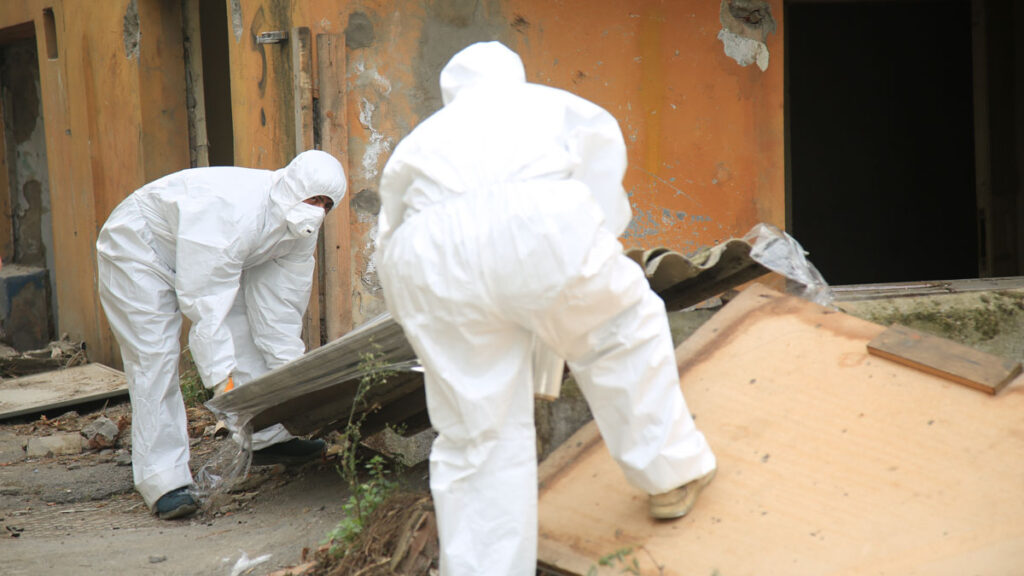RAAC stands for reinforced autoclaved aerated concrete. As the name suggests, it’s a lightweight aerated concrete that was often used in roofing, but could also be found in floors and walls too.
The potential for collapse or partial failure of aging RAAC has hit the headlines recently, however, the risk of asbestos lurking in the background hasn’t received the same level of publicity. Both asbestos and RAAC were widely used in construction in the 1950s to 1980s in schools, hospitals and other buildings so it’s likely that asbestos could be present in the same areas as RAAC. There have been no suggestions the RAAC itself contains asbestos, however the potential for the internal structure of such buildings to contain asbestos in ceiling panels, insulation and lagging presents a real risk. It’s a risk for those inspecting RAAC and carrying out remediation. There’s also the risk of asbestos fibres being released due to the damage of any asbestos containing materials in the event of the collapse of any parts of a RAAC structure.

The Health and Safety Executive (HSE) has said asbestos remains the biggest cause of work-related deaths in the UK with more than 5,000 deaths per annum being attributed to asbestos. It is estimated to cost the insurance industry over £200m each year.
The HSE also estimates that asbestos could be present in up to 1.5 million workplaces in the UK, as well as in many homes, despite efforts over the years to remove it.
What is Asbestos?
Asbestos is a mineral that is still being mined today in parts of Africa. There is evidence of it being used as far back as 2400BC to make pots and cooking utensils. In 1918 the U.S. Bureau of Labour Statistics reported on the early deaths of asbestos workers and in 1930 The UK Merewether report led to regulation in the manufacture of asbestos products but not those fitting them. Knowledge of asbestos-related disease is nothing new, yet asbestos importation and use in the UK was only banned in 1999.
Asbestos has thermal and acoustic insulating properties. It is also fire and chemical retardant, so it found its way into many products and buildings. Uses ranges from incorporation in fire blankets, oven gloves, all sorts of building insulation materials including cladding, gutters, partitions, pipe and heating lagging and floor and ceiling tiles.
It is estimated that 6 million tons of asbestos was imported into the UK between 1900 and 1999. The fibres were then mixed with magnesia, cement, and other materials to form the asbestos products. At an average of 20% asbestos in the product, that equates to 30 million tons of asbestos products. Then add in asbestos debris from incidents, or poor removal in the past, and the problem can involve a lot of residual dust and fibres.
Asbestos-Related Disease — Who is at Risk and Who is Responsible?
Asbestos- related diseases result from the inhalation of asbestos fibres which can be released when working with asbestos containing materials. This can lead to asbestosis, asbestosis with lung cancer and mesothelioma. Such diseases can have a latency period of anything from 15-35 years and are often fatal.
The nature of those prone to asbestos exposure has been changing. It is today’s builders and allied trades who are potentially at risk due to asbestos in buildings. Building contractors, joiners, shop fitters, plumbers, heating Engineers, electricians, computer cabling contractors can all be potentially exposed to asbestos. This exposure to legacy asbestos has been killing workers worldwide for decades with RAAC inspections and remediation now adding a further exposure.
The Control of Asbestos Regulations 2012 mean that commercial building owners and/or tenants are deemed duty holders in terms of being able to identify asbestos in the building. An Asbestos Register must list all asbestos found in the building with a note of its location and condition. It must be made available to contractors so they can manage their duty to their employees by not exposing them to asbestos which will be a critical part in assessing the risk involved in any RAAC remediation.
In addition, the aim to hit net zero targets is likely to further escalate exposure to asbestos as the additional work in the insulation of buildings is expected to result in more construction employees disturbing and being exposed to legacy asbestos in buildings.
How Can the Asbestos Risk be Mitigated?
Traditional thinking has been that removing asbestos from buildings can be more hazardous than leaving undamaged asbestos products in situ and managing it carefully. In 2022, the UK government debated proposals of a 40-year timeline for the regulated removal of asbestos from all public and commercial buildings. This would certainly be ground-breaking but wouldn’t be without risk. Asbestos itself doesn’t degrade over the time, so careful removal and disposal into regulated asbestos dumps would be required which would carry significant potential risks. There has been no further movement on this, with the official government response being “Great Britain has a mature and comprehensive plan to manage asbestos risk that aligns with the best evidence currently available.”
There’s no easy solution to the problem which will remain with us for decades to come – presenting a continuous need for vigilance and management of risk with the additional twist presented by RAAC.
If you’re concerned about your client’s potential risk exposure to asbestos, please discuss with your local Arch underwriter.
Data sourced from https://www.hse.gov.uk/asbestos/